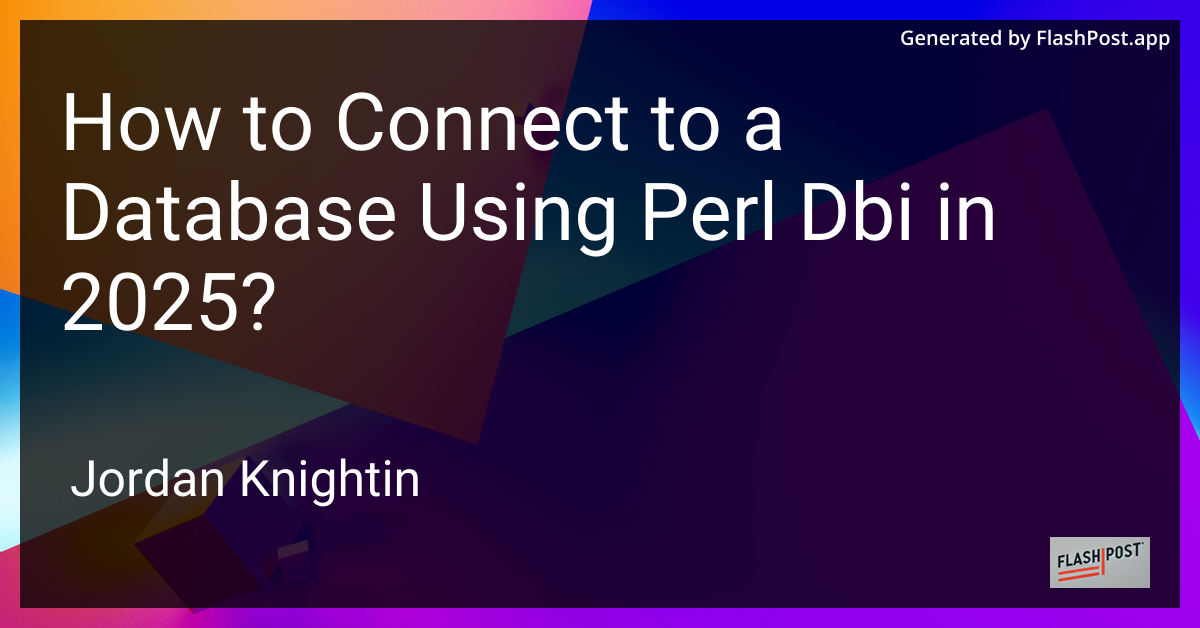

How to Connect to a Database Using Perl Dbi in 2025?
In the dynamic world of technology, connecting to databases using Perl DBI remains a pertinent skill, especially as we move into 2025. Perl, renowned for its text manipulation prowess and web development capabilities, coupled with the Database Interface (DBI), offers a robust method of database interaction. In this guide, we’ll delve into the steps necessary to effectively connect to a database using Perl DBI.
What is Perl DBI?
The Perl Database Interface (DBI) is a database access module for the Perl programming language. It defines a set of methods, variables, and conventions that provide a consistent database interface, independent of the actual database being used. The beauty of DBI is its ability to work with various database engines via driver modules such as DBD::mysql, DBD::Pg, and many more.
Prerequisites
Before diving into connecting to a database, ensure you have the following prerequisites:
- Perl Installed: Ensure that Perl is installed on your system. It’s shipping with most Unix-based systems or can be installed via package managers on Windows.
- DBI Module: You must have the DBI module installed. This can be achieved using CPAN:
cpan DBI - DBD Driver: Depending on your database, you may need to install a specific DBD driver. For example, for MySQL, you would install DBD::mysql:
cpan DBD::mysql
Step-by-Step Guide to Connect to a Database
Step 1: Load the DBI Module
First, ensure that you have loaded the DBI module at the beginning of your Perl script. This module provides the necessary functions for database interaction.
use strict;
use warnings;
use DBI;Step 2: Define Your Database Connection Parameters
You’ll need to define the data source name (DSN), username, and password for your database. The DSN specifies the driver name and database name.
my $dsn = "DBI:mysql:database_name:host:port";
my $username = "your_username";
my $password = "your_password";Step 3: Establish the Database Connection
Utilize the DBI->connect method to establish a connection. Handle any potential errors during connection gracefully.
my $dbh = DBI->connect($dsn, $username, $password,
{ RaiseError => 1, PrintError => 0 }
) or die $DBI::errstr;Step 4: Query the Database
Once connected, you can execute queries using the prepare and execute methods. Here’s a simple example of selecting data:
my $sth = $dbh->prepare("SELECT * FROM your_table");
$sth->execute();
while (my @row = $sth->fetchrow_array()) {
print "Row: @row\n";
}
$sth->finish();Step 5: Disconnect
Always ensure that you disconnect from the database once operations are complete to free resources.
$dbh->disconnect();Conclusion
Connecting to a database using Perl DBI in 2025 is much like in years past while maintaining the principles of secure and efficient database interactions. By following the outlined procedures, you ensure robust and error-free connectivity. Whether you are managing legacy systems or developing new applications, Perl DBI remains a vital tool in the developer’s toolkit.
For more Perl-related projects, consider exploring these topics:
- Cleaning Milk Frother Properly: Discover techniques for maintaining kitchen appliances.
- Sending SMTP Email in Perl: Learn how to enhance your Perl scripts with email capabilities.
- Network Monitoring Using Perl: Delve into network management with Perl for insightful data monitoring.
By embracing these tools and techniques, you can achieve efficient database management and further Perl proficiency.
